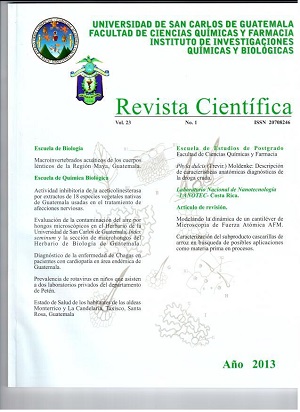Health status of the villagers Monterrico and Candelaria Taxisco, Santa Rosa, Guatemala.
Keywords:
water well, anemia, health status, health indicators, desrmatophytes, antibodies againstAbstract
Abstract
In order to establish the health status of the villagers in Monterrico and La Candelaria, Taxisco, SantaRosa in Guatemala, we assessed the following health indicators: microbiological quality of waterwells from the villagers houses, malaria and anemia analysis, fungal dermatophytes, prevalence ofdengue antibodies (IgG and IgM) and prevalence of antibodies against Helicobacter pylori (IgG) ineach of the habitants on the selected houses, and body mass index (BMI) and presence of intestinalparasite infections in scholars. Sampling and data collection was conducted using a cluster randomizeddesign, where 26 houses in the village of La Candelaria and 30 houses in the village of Montericowe selected and all the residents of such houses where included in the study. The results indicatedtotal coliform contamination in wells from both villages in a proportion of 70% in La Candelaria and80% in Monterrico, and also fecal coliform contamination in 30% in the village La Candelaria and53.3% in Monterrico. Prevalence of dermatophyte fungal infections was 34.2% in Monterrico and37.1% in La Candelaria, and the presence of intestinal parasites in schoolchildren was 13.6% inMonterrico and 18.7% in La Candelaria, indicating poor community health. Prevalence of denguein the community was established to be equivalent as to what occurs in other regions of the country,opposite to the result for the prevalence of Helicobacter pylori antibodies, which were below to thelevels shown in other populations. It was also found, that preventive measures against malaria havehad an effective effect in both villages since no positive cases were revealed. This study contributeswith the communities in the villages of Monterrico and La Candelaria, to become aware of the healthstatus of their people, to plan intervention measures and to monitor health conditions in the villages.
Keywords: water well, anemia, health status, health indicators, dermatophytes, antibodies againstH. pylori and dengue.
References
Referencias
Anacleto, F., (2007). Calidad Microbioógica del
Agua de Consumo Humano de Tres
Comunidades Rurales del Sur de Sonora.
Revista Salúd Pública y Nutrición. Vol
:3.
Behrman, R. (2004). Nelson Tratado de Pediatría.
España: Editorial Elsevier
Cifuentes, G., Silvestre, Y., Lange, K. y Matta,
V. (2012). Frecuencia de anticuerpos IgG
anti Helicobacter pylori en expendedores
de alimentos de la ciudad universitaria,
zona 12. Revista Científica, 22(1), 24-29.
Coma J. y Bonet J., (2004). Producción ganadera
y contaminación ambiental. XX Curso
de Especialización FEDNA.Barcelona.
Grupo Vall Companys.
INE. (2009). Población y locales de habitación
particulares censados según departamento
y municipio. Guatemala. 38 pp.
Jiménez R. (2008). Malaria en España: aspectos
entomológicos y perspectivas de futuro.
Revista Española de Salud Pública. 82(5)
Lange, K., Matta, V., Nave, F., Alvarado, V.,
Camo, M., et al. Frecuencia de anticuerpos
IgM e IgG anti Helicobacter pylori en
estudiantes, personal docente y
administrativo de la Facultad de Ciencias
Químicas y Farmacia. Revista Científica,
(1), 96-101.
Mahan, K. y Escott, S. (2000). Nutrición y
dietoterapia de Krause. México, McGraw-
Hill. 1274 p
Mogollón, D. (2001). Factores condicionantes
del estado nutricional de la población
preescolar que asiste a la escuela
parvularia “Demetria Linares†de la
cabecera departamental de Sololá. Tesis
médico y cirujano. Universidad de San
Carlos de Guatemala.
Organización Panamericana de la
Salud/Organización Mundial de la Salud.
(2008). Desnutrición Infantil en las
Américas: Cumplimiento de los Objetivos
de Desarrollo del Milenio. Washington
DC: WHO.
Perea, S., et al. (2000). Prevalence and risk
factors of tinea unguium and tinea pedís
in the general population in Spain. Clinical
Microbiology. 38: 3226-30.
Pérez C, M. et al. (2007).Intervención educativa
y parasitismo intestinal en niños de la
enseñanza primaria. Revista Cubana de
Medicina General Integral. 23(2)
Programa de vectores, D. g. (2007). Proyecto
de la Iniciativa Multisectorial para Reducir
la Malaria en Cinco áreas Prioritarias de
Guatemala. Manual Operativo para la
Vigilancia y Control de las Fases
Inmaduras de los Vectores de Malaria en
Guatemala. , Ministerio de Salud Pública
y Asistencia Social, pp. 11-13.
Sánchez-Pérez, H.J. M.G. Vargas-Morales y J.
D. Méndez-Sánchez, (2000). Calidad
bacteriológica del agua para consumo
humano en zonas de alta marginación de
Chiapas. Revista Salud Pública de México.
(5), 397-406.

